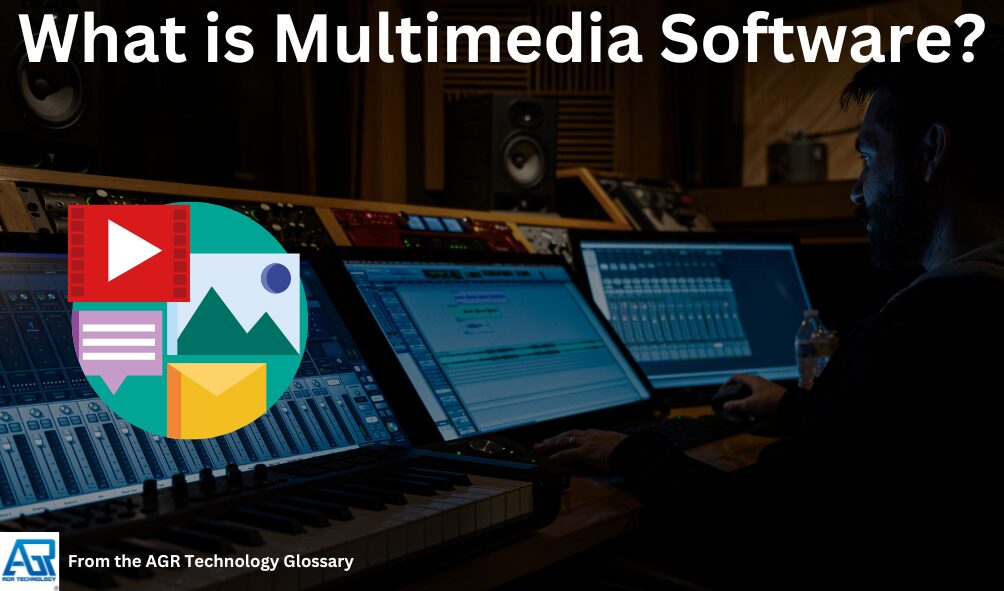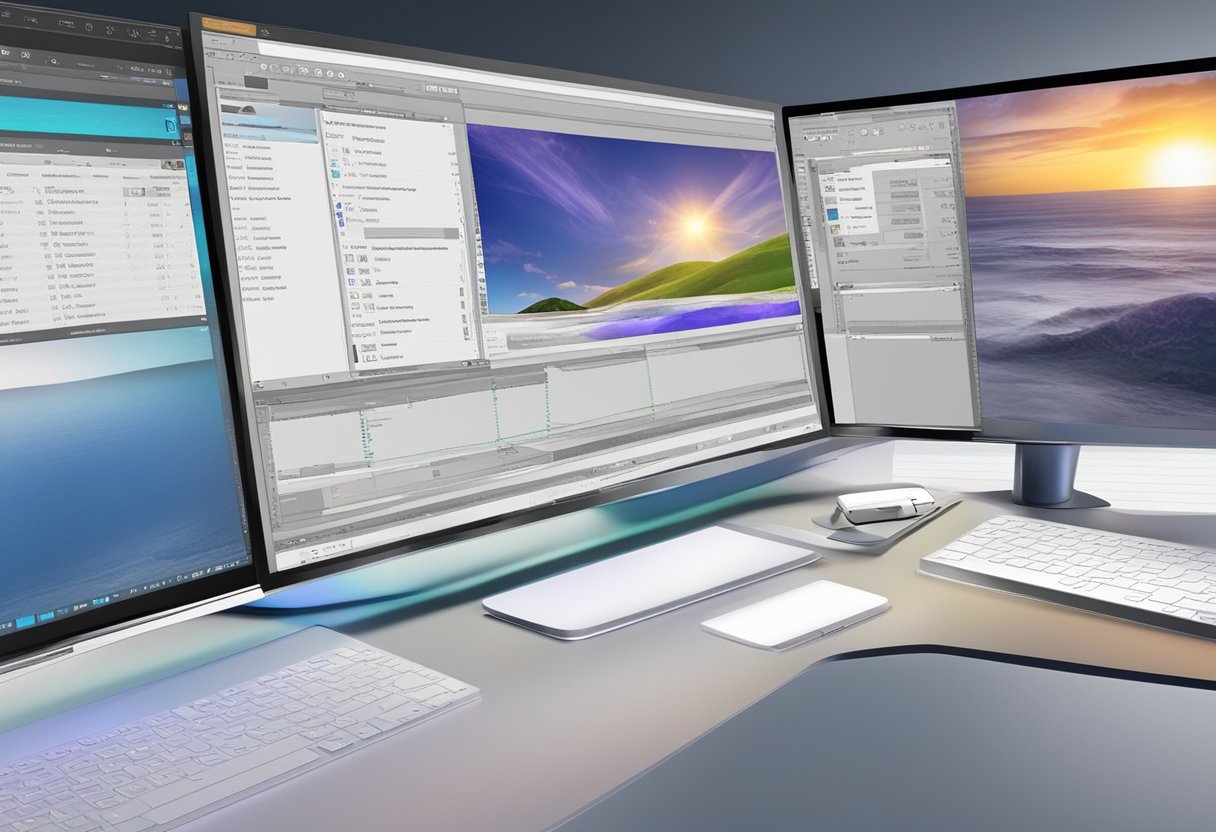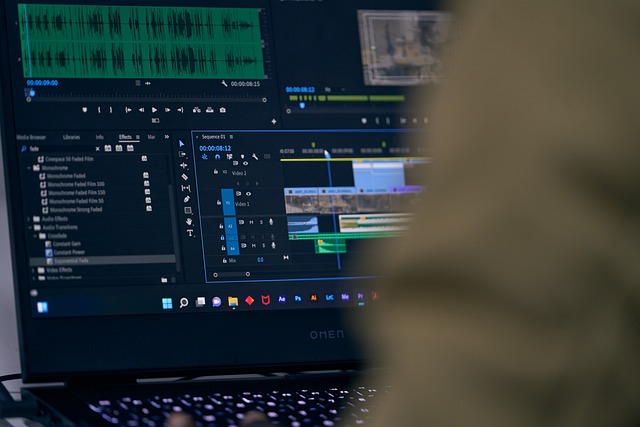What is Multimedia Editing Software? A Clear Explanation

Multimedia editing software is an essential tool for content creators who need to manipulate different types of media. It allows users to edit and combine various forms of media, including audio files, podcasts, images, and video, to create a cohesive and compelling final product and is a core part of content creation strategies such as audio that gets uploaded to podcast hosting sites or video platforms like YouTube.
Understanding Multimedia Editing Software Multimedia editing software is a type of software that enables users to edit and manipulate different types of media. This includes video editing software, audio editing software, and image editing software. With multimedia editing software, users can create professional-looking videos, edit music tracks, and enhance images.
Selecting the Right Software for Your Needs Selecting the right multimedia editing software depends on your specific needs. For instance, if you are a professional video editor, you may require advanced editing features and tools. On the other hand, if you are a beginner, you may want to start with software that is easy to use and has a low learning curve. Additionally, you should consider the cost and accessibility of the software, as well as any software-specific insights that may be relevant to your needs.
Key Takeaways
- Multimedia editing software is a type of software that allows users to edit and manipulate different types of media, including audio, images, and video
- Choosing the right multimedia editing software depends on your specific needs, including your level of expertise, the features and tools you require, and the cost and accessibility of the software
- Advanced editing features and tools, software-specific insights, and ease of use are all important factors to consider when selecting multimedia editing software
Understanding Multimedia Editing Software and common functionality

Multimedia editing software is a powerful tool that allows users to manipulate, edit, and create multimedia content. This type of software is widely used in the film, television, and advertising industries, as well as by individuals who want to create their own multimedia content. This section will cover the core functions of multimedia editing software, the popular formats supported, and the software platforms available.
Core Functions
Multimedia editing software typically offers a range of core functions. These functions include video editing, audio tools, effects, filters, and transitions. With video editing, users can cut, trim, and arrange video clips to create a cohesive story. Audio tools allow users to edit and mix audio tracks, adjust volume levels, and add sound effects. Effects, filters, and transitions can be used to enhance the visual and auditory experience of the multimedia content.
Popular Formats Supported
Multimedia editing software supports a wide range of formats, including video, audio, and image formats. Popular video formats supported include MP4, AVI, MOV, MKV and WMV. Audio formats supported include MP3, WAV, and AIFF. Image formats supported include JPEG, PNG, and GIF. It is important to note that different software may support different formats, so it is important to check the software’s specifications before purchasing.
Software Platforms
Multimedia editing software is available on a variety of software platforms, including Windows, MacOS, and cross-platform options. Windows-based multimedia editing software includes Adobe Premiere Pro, CyberLink PowerDirector, and Vegas Pro. MacOS-based multimedia editing software includes Apple Final Cut Pro X, Adobe Premiere Pro, and iMovie. Cross-platform multimedia editing software includes Adobe Premiere Pro and DaVinci Resolve.
In conclusion, multimedia editing software is a powerful tool that allows users to create, edit, and manipulate multimedia content. Understanding the core functions, popular formats supported, and software platforms available is crucial when choosing the right multimedia editing software for your needs.
Selecting the Right Software for Your Needs
When it comes to selecting the right multimedia editing software, there are a few things to consider. The following subsections will help you make an informed decision based on your needs.
Software for Professionals vs. Beginners
Professionals and beginners have different needs when it comes to multimedia editing software. Professionals require software that can handle complex projects, offer advanced features, and can handle large files. On the other hand, beginners require software that is easy to use and has a simple interface.
Considering the Learning Curve
The learning curve is an important factor to consider when selecting multimedia editing software. Some software is more complex and requires more time to learn, while others have a simpler learning curve. For beginners, it’s important to select software that has a shorter learning curve to get started quickly. For professionals, it may be worth investing more time to learn complex software with advanced features.
Importance of User Interface
The user interface is an important factor to consider when selecting multimedia editing software. A simple and intuitive interface can make the editing process faster and more efficient. On the other hand, a complex and cluttered interface can make it difficult to find the features you need. Therefore, it’s important to select software with a user-friendly interface that suits your needs.
Overall, selecting the right multimedia editing software depends on your needs. Professionals may require advanced software with complex features, while beginners may require simple and easy-to-use software. Consider the learning curve and user interface to make an informed decision.
Advanced Editing Features and Tools
Multimedia editing software offers a wide range of advanced features and tools that allow users to create professional-looking videos with ease. Here are some of the most common advanced editing features and tools that are available in multimedia editing software:
Color Grading and Audio Editing
Color grading is an essential part of video editing that involves adjusting the colors and tones of a video to achieve a specific look or mood. Many multimedia editing software applications come with built-in color grading tools that allow users to adjust the brightness, contrast, saturation, and other color settings of their videos.
Audio editing is another essential feature of multimedia editing software. With audio editing tools, users can adjust the volume, add sound effects, remove background noise, and more. Some multimedia editing software applications also come with built-in audio libraries that users can use to add music and other sound effects to their videos.
Visual Effects and Motion Tracking
Visual effects (VFX) are a popular feature of multimedia editing software that allows users to add special effects to their videos. VFX can be used to create explosions, fire, smoke, and other effects that would be difficult or impossible to achieve in real life.
Motion tracking is another advanced feature of multimedia editing software that allows users to track the movement of objects in their videos. With motion tracking, users can add text, graphics, and other elements to their videos that move along with the objects they are tracking.
Multicam and 360-Degree Video Editing
Multicam editing is a feature that allows users to edit footage from multiple cameras at the same time. This is a useful feature for live events or interviews where multiple cameras are used to capture different angles of the same event.
360-degree video editing is another advanced feature of multimedia editing software that allows users to edit videos that were shot with a 360-degree camera. With 360-degree video editing tools, users can adjust the perspective of their videos, add text and graphics, and more.
Overall, multimedia editing software offers a wide range of advanced features and tools that allow users to create professional-looking videos with ease. Whether you’re editing a simple home video or a complex commercial project, multimedia editing software has the tools you need to get the job done.
Software-Specific Insights

Adobe Premiere Pro and Elements
Adobe Premiere Pro is a widely used multimedia editing software that offers a comprehensive set of tools for video editing, audio editing, and color correction. It is a professional-grade software that is used by filmmakers, video editors, and content creators. Premiere Pro allows users to work with a wide range of video formats and resolutions, including 8K and virtual reality. It also offers advanced features such as motion graphics, 3D editing, and VR editing.
On the other hand, Adobe Premiere Elements is a more simplified version of Premiere Pro, designed for beginners and hobbyists. It offers a user-friendly interface with basic editing tools such as trimming, cutting, and adding effects. Premiere Elements is a good option for those who want to edit videos without the steep learning curve of Premiere Pro.
Final Cut Pro and iMovie
Final Cut Pro is a multimedia editing software developed by Apple Inc. It is a professional-grade software that is used by filmmakers, video editors, and content creators. Final Cut Pro offers a wide range of tools for video editing, audio editing, and color correction. It also allows users to work with a wide range of video formats and resolutions, including 8K and virtual reality. Final Cut Pro is known for its user-friendly interface and intuitive workflow.
iMovie, on the other hand, is a more simplified version of Final Cut Pro, designed for beginners and hobbyists. It offers a user-friendly interface with basic editing tools such as trimming, cutting, and adding effects. iMovie is a good option for those who want to edit videos without the steep learning curve of Final Cut Pro.
DaVinci Resolve and HitFilm Express
DaVinci Resolve is a multimedia editing software developed by Blackmagic Design. It is a professional-grade software that is used by filmmakers, video editors, and content creators. DaVinci Resolve offers a wide range of tools for video editing, audio editing, and color correction. It also allows users to work with a wide range of video formats and resolutions, including 8K and virtual reality. DaVinci Resolve is known for its advanced color correction tools and its ability to handle complex projects.
HitFilm Express is a more simplified version of DaVinci Resolve, designed for beginners and hobbyists. It offers a user-friendly interface with basic editing tools such as trimming, cutting, and adding effects. HitFilm Express is a good option for those who want to edit videos without the steep learning curve of DaVinci Resolve.
Other multimedia editing software options include Corel VideoStudio and Corel VideoStudio Ultimate, which offer a range of features for video editing, audio editing, and color correction. However, they are not as widely used as the software mentioned above.
Cost and Accessibility

Multimedia editing software can vary greatly in cost and accessibility, depending on the specific software and its features. In this section, we’ll explore some of the key factors to consider when evaluating the cost and accessibility of multimedia editing software.
Subscription vs. One-Time Purchase
One of the primary decisions to make when selecting multimedia editing software is whether to opt for a subscription-based model or a one-time purchase. Subscription-based models typically require ongoing payments, often on a monthly or annual basis, in order to continue using the software. One-time purchases, on the other hand, involve a single payment for lifetime access to the software.
Subscription-based models can be more affordable upfront, as they often offer lower initial costs. However, the ongoing payments can add up over time, making them less cost-effective in the long run. One-time purchases, while more expensive upfront, can be a better value over time, particularly for users who plan to use the software for an extended period of time.
Free vs. Paid Options
Another key consideration when evaluating multimedia editing software is whether to opt for a free or paid option. Free video editing software can be a great choice for beginners or those on a tight budget, as they offer basic editing features without any cost. However, free options may be limited in terms of features and functionality, and may not be as user-friendly as paid options.
Paid options, while more expensive, often offer more advanced features and greater flexibility. They may also come with additional support and tutorials to help users get the most out of the software. For users who are serious about multimedia editing, a paid option may be the best choice.
Support and Tutorials Availability
When selecting multimedia editing software, it’s important to consider the availability of support and tutorials. Many software providers offer extensive support resources, including online tutorials, user forums, and email or phone support. These resources can be invaluable for users who are new to multimedia editing or who encounter technical issues.
In general, paid software options are more likely to offer extensive support and tutorials than free options. However, some free options may also offer helpful resources for users. It’s important to evaluate the availability of support and tutorials when selecting multimedia editing software, particularly for users who are new to the field.
Overall, when evaluating multimedia editing software, it’s important to consider factors such as subscription vs. one-time purchase, free vs. paid options, and support and tutorials availability. By carefully evaluating these factors, users can select the best software for their needs and budget.
Frequently Asked Questions
What are the primary functions of multimedia editing software?
Multimedia editing software is designed to edit audio, video, and images. The primary functions of multimedia editing software are to manipulate and enhance multimedia files. This includes cutting, trimming, and splicing video and audio files, adding special effects, and adjusting color and lighting in images.
Can multimedia editing software be available for free?
Yes, there are several free multimedia editing software options available for personal use. These programs may not have all the features of paid software, but they can still be effective for basic editing tasks. Some popular free options include Blender, Shotcut, and DaVinci Resolve.
What are some well-regarded multimedia editing programs for personal computers?
There are several well-regarded multimedia editing programs available for personal computers. Some popular options include Adobe Premiere Pro, Final Cut Pro, and Avid Media Composer. These programs offer a wide range of features and are commonly used in professional settings.
Could you provide examples of software used for audio editing?
Some examples of software used for audio editing include Audacity, Adobe Audition, and Pro Tools. These programs allow users to edit audio files by adjusting volume levels, removing background noise, and adding effects.
What are the top choices for professional video editing software?
The top choices for professional video editing software include Adobe Premiere Pro, Final Cut Pro, and Avid Media Composer. These programs offer advanced features such as multi-camera editing, color correction, and special effects.
Why is video editing software considered crucial in multimedia production?
Video editing software is considered crucial in multimedia production because it allows creators to manipulate and enhance video footage. This includes adding special effects, adjusting color and lighting, and cutting and splicing footage. Without video editing software, multimedia projects would not be able to achieve the level of polish and professionalism that is expected in today’s media landscape.
Related content from our technology glossary:
![logo-new-23[1] logo-new-23[1]](https://agrtech.com.au/wp-content/uploads/elementor/thumbs/logo-new-231-qad2sqbr9f0wlvza81xod18hkirbk9apc0elfhpco4.png)